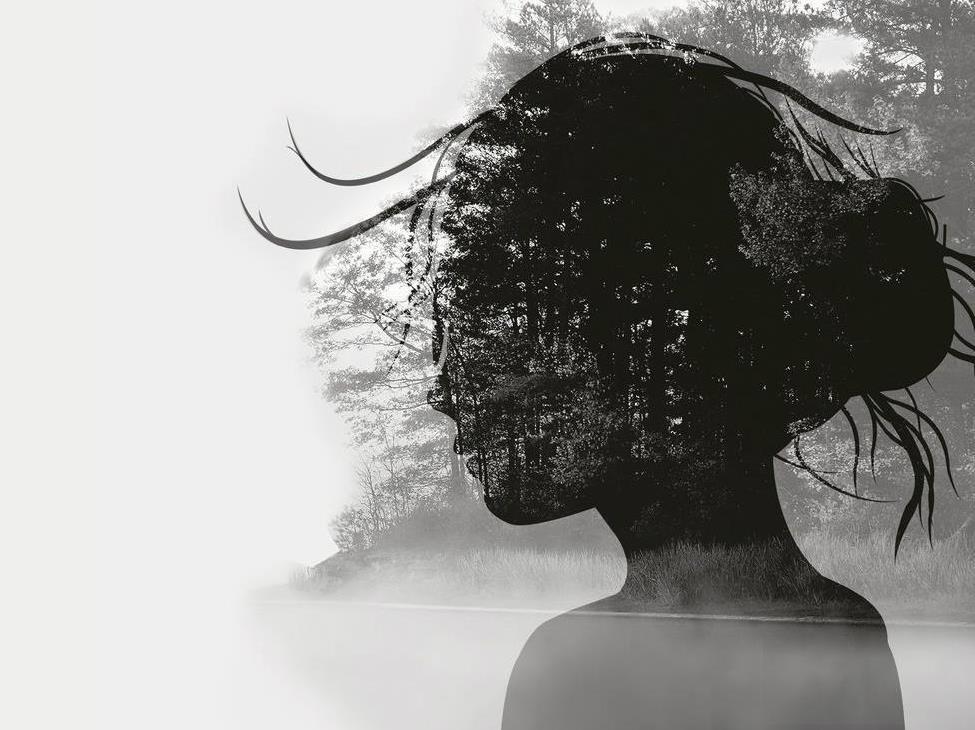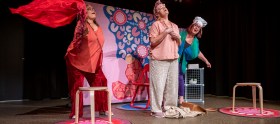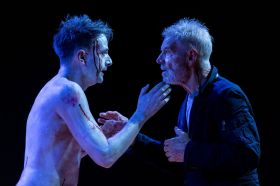Promotional image for Mudlark Theatre’s I Am A Lake via theunconformity.com.au
Fusing a European literary tradition with the bloody history of Van Dieman’s Land’s colonial past, and drawing inspiration from the land itself, the Tasmanian Gothic runs like a rich, dark seam through the art and culture of the island state.
Leigh Carmichael, the Creative Director of winter festival Dark Mofo, believes the popularity of the gothic is largely driven by Tasmania’s history, and how the state was colonised.
‘Our main tourist icon for a very long time was [the former convict settlement] Port Arthur. The backbone of our tourist industry has been built around violence and pain and darkness, if you like, and our architecture’s quite gothic, our landscape is quite violent, that’s one way to describe it – the mountain peaks. So yeah I think the place just feels gothic. It’s quite gloomy, we do have long nights, so it’s not a surprise really that that’s the dominant narrative. It’s deep in our psyche,’ he said.
While some of the genre’s motifs speak to history and to themes of horror, mystery and the uncanny, the Tasmanian Gothic is also deeply rooted in place, according to Rachel Edwards, Editor in Chief of the Tasmanian publishing house Transportation Press.
‘I think the Tasmanian Gothic in literature is about place as much as story,’ she said. ‘That dense, dark, wet forest plays into it quite a lot, and if you think about something like Julia Leigh’s The Hunter, even Favel Parrett’s Past the Shallows, it very much plays on that sense of isolation and of desolate characters, but I think it’s primarily place that makes Tasmanian Gothic so distinctive; it’s driven by place.’
As evidenced by the likes of Jonathan auf der Heide’s film Van Diemen’s Land (2009) and television productions including The Kettering Incident (2016) and the in-development The Gloaming, the Tasmanian Gothic also fascinates screen-based artists.
Briony Kidd, the co-founder and programmer of Hobart’s horror film festival, Stranger With My Face, notes that there’s an element of contrivance to the gothic’s popularity.
‘On the one hand it’s clearly driven in an authentic way by what artists are interested in, but on the other hand there’s a marketing component to it as well. And when you have festivals or films or anything really, the marketing aspect is always going to be part of the creation or the curation of the work. Particularly when you’re talking about film, which is probably the most commercial of all art forms, it’s almost impossible to separate marketing from creation,’ Kidd said.
‘I’m particularly interested in genre films, horror specifically, and that in a large part is to do with reinforcing familiar elements so that audiences can be comfortable with what you’re offering … but also there’s the ability to subvert the traditions and comment on the traditions at the same time. So I would look at the idea of the Tasmanian Gothic in a very similar way personally, which is that it may be useful in terms of building an audience, because you’re talking about an identity or a brand or a concept that becomes associated with this place.’
Dark Mofo has been extremely successful when it comes to marketing the Tasmanian Gothic, according to Peter Choraziak, Festival Director of Hobart’s Festival of Voices.
‘The main protagonists of the Tasmanian Gothic is a festival called Dark Mofo. They are excellent marketers, they really are. So they play that card really well and just through sheer weight of marketing and dollars that tends to be a pervasive sort of story,’ he said.
Read: The allure of art in the dark: why we love winter festivals
As an island off an island at the bottom of the world, Tasmania has been long been viewed as geographically and emotionally isolated, according to Liz Frankham, Chair and President of Launceston’s Junction Arts Festival. Such isolation also feeds into the Tasmanian Gothic.
‘When acclaimed Australian historian and art critic, Robert Hughes, published his The Fatal Shore in 1986, on the history of the birth of Australia out of the suffering and brutality of Britain’s convict transportation system, he is quoted as saying that “America was God Blessed and Australia was God Forsaken” – well what does that make Tasmania, God Forsaken on steroids? Such has been the pervading view of the dark, gothic past of this small island of 500,000 people,’ Frankham said.
‘Ironically this has become a cultural advantage, a selling point to the world. Even in the recent David Attenborough Tasmania doco, one sees wild, snow-capped mountains, and forested gullies with creatures that are large, deadly and not like anywhere else. The people who populate this foreign exotic faraway land must be quite extraordinary and resilient… and so the myth perpetuates,’ she added.
For many years, however, Tasmanian tourism pushed a very different message, according to Carmichael.
‘Tourism ran with these beautiful images of landscapes and beaches and blue skies, and they did that for 20 or 30 years. And it was interesting how quickly, when Dark Mofo came out, how soon we went to the darker images, the misty mountains and trees – and how quickly they just dominated instantly, because it’s the truth. It was almost like 30 years of tourism was undone, because it just doesn’t really ring true, I guess. And I find that kind of intriguing,’ Carmichael said.
Choraziak, however, rejects the suggestion that the Tasmanian Gothic is a natural marketing fit for the island.
‘“Gothic” probably wouldn’t be in my top ten words if I was to describe the culture of Tasmania to others; it’s something that doesn’t flow off the tongue very well. It’s been packaged very well – “Let’s celebrate the dark, let’s celebrate the longest night of the year and do weird shit around it.” But look, a lot of that weird shit has been borrowed from overseas, which is fine, and we’ve kind of made them our own. There’s nothing new about a nude swim, there’s nothing new about burning an effigy – and the ogoh-ogoh … it’s a lovely, traditional thing to do but it’s not our tradition,’ he noted.
‘I think the Tasmanian Gothic is the low-hanging fruit as far as storytelling goes, and that’s why we’re seeing a lot of it and why people are lapping it up, because they’re loving those stories. You could argue there’s one school of thought that says “Let’s do more of the same because people are enjoying it,” but at the same time I think we’re set to see some other, different approaches very soon.’
Stories new and old
While the Tasmanian Gothic is a dominant trope, it’s far from being the state’s only narrative or cultural tradition. Tasmania’s oldest stories predate European colonisation by some 50,000 years.
Sinsa Mansell, a proud Tasmanian Aboriginal woman from the state’s north, is a performer, choreographer and co-founder of pakana kanaplila – a Tasmanian Aboriginal dance troupe fusing traditional and contemporary cultural practices.
‘Even though Tasmanian Gothic is not a term that resonates with me personally – I’m not one to associate horror and gloom with the island I am so deeply passionate about – I also see why this genre is booming. The many structures, sites and historic events are very fitting to the term,’ Mansell said.
With a practice focused on respecting and honouring the island state’s ancient culture and the living traditional practices of her ancestors, Mansell said she believes in acknowledging all history.
‘I am also one to see the positive in the negative, the bad in the ugly, the light in the dark. Meaning I see the beauty in the dark history too. The demographic that identifies with the gothic generally, I believe, is also honouring the historical history of Tasmania. I find myself stating regularly that our isolation has been a gift. Our ancient forests, the pristine natural environment, the architectural sights all highlight and showcase the natural beauty of this magnificent island. As an artist I see exactly why the gothic is fitting.’
Mansell said that personally, she believes the growing interest in Tasmania’s past has been positive for many industries and practices.
‘All places and cultures evolve. I don’t see [the gothic] overshadowing the history of my ancestors because we are strong and we will continue to live our lives practicing the ancient and thriving living traditions. We have always been here. Like I said, we are strong. We are heard. We are seen. We honour and will evolve, like all living beings. This boom [in the gothic] is not a concern … It is of no harm,’ she told ArtsHub.
Artists from other traditions also recognise the diversity of the state’s culture and stories.
‘Tasmania is like anywhere else: there are love stories here, there are coming of age stories, there are ghost stories – which probably fits more into the gothic, I suppose,’ said poet, playwright and novelist Cameron Hindrum.
So are there other Tasmanian narratives that the gothic has overshadowed until recently? ‘I think there’s a couple of ideas worth exploring,’ Hindrum replied. One is the idea of Tasmania’s – and I hate to use this word because it’s a very clumsy word – but Tasmania’s “Islandness”. I think there’s a sense that quite a lot of literature and film ideas that come out of Tasmania explore the idea that we are kind of cut off, and that we make our own connections with different parts of the world that way, or have things in common with different parts of the world that way.
‘And the other one that I think possibly is also worth considering is this idea of the leaving – having to go away to make something of yourself or pursue dreams or whatever, and then either come back or not, because there’s quite a bit of that.’
From his home in Launceston, Hindrum has not only identified the increasing diversity of a number of Tasmanian narratives – he has also directly contributed to them.
‘Certainly the novel I published a few years ago drew heavily on the Franklin Dam [campaign of the late Seventies and early Eighties], and so as you asked that question [about narratives], the first words that came into my mind were “Of course – there’s a history of protest in Tasmania, there’s a history of activism.” That’s quite entrenched as well, and in fact is making itself known across a few different means of expression. For example, I know that the Tasmanian Theatre Company later this year are staging a production that I think is about the gay rights movement … a kind of verbatim piece. So that sort of story is starting to emerge now too, and that’s an important part, I think, of Tasmania’s more recent cultural fabric.’
Emerging literary traditions
Rachel Edwards is adamant that contemporary Tasmanian literature is moving away from the gothic.
‘A lot of our short story writers, as much as they bring in place, they don’t make it into this dark, blood-soaked historical thing. And especially with some of the emerging writers, the gothic is not there at all,’ she said.
As an example she points to Robbie Arnott’s ‘ripper new book Flames, which has just come out through Text Publishing. While it is fiercely Tasmanian and very much of place, I wouldn’t call it Tasmanian Gothic at all. And with somebody like Adam Ouston, who’s written some great short fiction, there’s an almost Continental, Austrian tone going on in some of his work.’
Ultimately, Edwards said, the Tasmanian Gothic is a stereotype, and one often perpetuated by outsiders.
‘I think often people writing from outside Tasmania or writing historical fiction still play around with the gothic,’ she said, ‘but I think it’s a stereotype, and I think that there’s so much more going on in our writing, way more.’
Under-representation of Tasmanian writers in mainland festivals means that the rest of the country is not always aware of contemporary trends in the state’s literature, she added.
‘By dint of physical distance we just don’t get to have those conversations and there’s less Tasmanian writing presence in a lot of the festivals,’ Edwards said.
Trope as trap and future narratives
Darren Willmott, the Artistic Director of Launceston’s Mudlark Theatre Company, said the Tasmanian Gothic is potentially a trap for artists.
‘At a company like Mudlark, you can potentially be boxed into something like that as a genre, even when you’re not actively seeking to do so … The possibilities for that theatrically rich drama, all that sort of stuff that can come out of a genre like the gothic are attractive, but it is a bit of a trap, because it is something that you can easily fall into all the time, if you’re not careful,’ he said.
Willmott believes the Tasmanian Gothic fascinates so many artists because it allows them to explore the darker side of Tasmanian history.
‘People have a kind of fascination with that darker side, and horror and things like that, because the history in Tasmania is full of that – and it makes me think that maybe in the modern day we’re just trying to come to terms with that history by exploring those themes in different ways,’ he said.
But for Willmott, there are more urgent themes to explore. ‘At Mudlark we’re looking for work that is theatrically rich and socially relevant to the time that we’re in … work that explores what it means to be a Tasmanian.’
He points to the company’s recent production of Cameron Hindrum’s first play, I Am A Lake, as an example of the sort of work he is interested in.
‘What I really loved about that story is that it was exploring a social issue of the time, of the Eighties, about communities and resource-based economies as opposed to new economies. So with that particular show it was set during the [Franklin] dam period, and the other kind of themes that came out of that show were exploring things like domestic violence. And so for me, I’m interested in what’s coming out of society that we need to deal with – whether it be addiction or violence or the ways we inhabit the environment we live in, all those sort of things for me are what I’m interested in more than the gothic,’ Willmott said.
At the Stranger With My Face film festival, Briony Kidd is also actively engaged in developing new Tasmanian narratives and genres.
‘We have a script competition called the Tasmanian Gothic Script Challenge, and then we also have another competition, a 48 hour challenge, which is called the Tasploitation Challenge, so that was like a really specific way to try and prompt people to think about idea of “Tasploitation” as a filmmaking style and maybe accelerate it a little … [We’re trying to] say, “What is our lowbrow aesthetic here,” I guess. What might we propose as a sort of Tasmanian B-grade film style or exploitation style?
‘Because we do have our own traditions here and our own pop culture – funny, silly little ads that we remember from childhood that were only screened here, and TV shows like Fatty and George, which was a kids sci-fi show in the Eighties.
‘We have our own cultural history that I guess in a lot of different ways is still under-explored or under-appreciated, so I can sort of see as we’re sort of gaining confidence culturally, that this sort of splintering will occur and all sorts of little themes and pockets of culture will flourish and get stronger,’ Kidd said.
As new narratives are established in the coming years, the allure of the gothic will likely wane, according to Junction’s Liz Frankham.
‘While there will always be an enduring legacy of our dark past,’ she said, ‘it will become less so as people from more diverse backgrounds settle in Tasmania, and the biological connections to our convict past lessens; there are now seven generations from white settlement to contemporary Tasmania. However, while we still have good story tellers intrigued by our gothic past there will always be some narrative to share.’
Dark Mofo: 8-24 June 2018
Festival of Voices: 29 June – 15 July 2018
Junction Arts Festival: 5-9 September 2018






